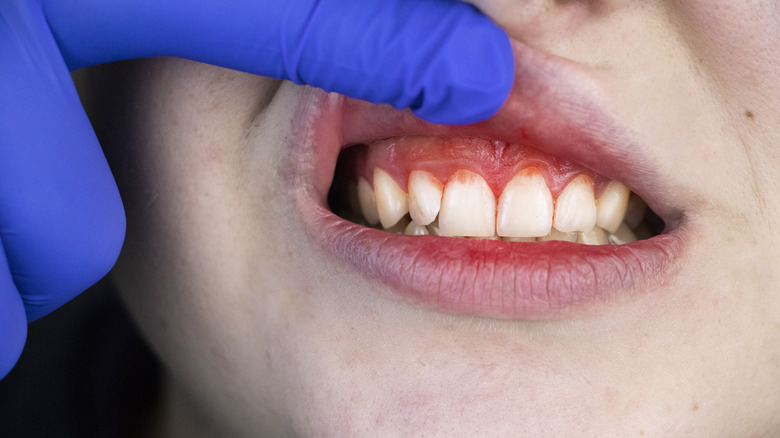Tingling in your mouth may be the first sign that something more severe is about to emerge in the form of tooth or gum pain, or perhaps you wake up one morning with a sore jaw. Mouth pain can be extremely bothersome and can affect your ability to eat, drink, sleep, and even speak (via StarBrite Dental). Determining whether your pain is stemming from your teeth or your gums is the first step in discerning what has gone awry and how to treat it. From swelling to bleeding to tenderness, there are ways to figure out if your pain is coming from your gums or if it’s attributed to one or more teeth.
Both gum and tooth issues can cause similar issues, which can make finding the root cause confusing at times (per MyHealth Alberta). Mild tenderness and sensitivity can be symptoms shared by both oral culprits, though there are some key differences to be on the lookout for when it comes to differentiating gum and tooth pain. For instance, toothaches may have pain isolated to a single tooth, and that one area of your mouth may be sensitive to sensations of temperature and composition of the food you eat, like hot and cold beverages or items that are very sweet or sour. If your gums are the reason for mouth pain, you may notice red, swollen gum tissue or bleeding after eating, touching your gums, or brushing your teeth. Read on for more about discerning gum and tooth pain.
Causes of gum and tooth pain

Tooth pain can be caused by conditions like broken teeth, cavities, and decay of tooth enamel (per StarBrite Dental). Pain in or around teeth can also be pain that is radiated from a sinus infection or severe sinus pressure, an earache or ear infection or pain from gums. Bruxism is a disorder where teeth grinding occurs at night during sleep and results in tooth pain, in addition to other symptoms, including headaches, sleep disturbances, difficulty eating, and noticeable wear on teeth, according to Cleveland Clinic.
Officially called periodontal disease, gum pain is often rooted in gum disease and frequently results from chronic inflammation or infection of the gum tissue in the amount, as per the Centers for Disease Control and Prevention (CDC). Gum disease often results in gums that are red in color, swollen, and bleeding. It can also be a deceiving gum issue since symptoms frequently include teeth that are loose or tender to the touch and even noticeable changes in the arrangement of your teeth or your bite. However, knowing these symptoms can help you discern periodontal disease as a gum issue, instead of merely tooth pain. If gum pain isn’t a result of gum disease, then it could be due to a gum abscess (via Mansfield Dental Associates). A gum abscess can result from the spread of a tooth abscess and can likely be easily identified by pain and infection in one specific spot in your mouth.




